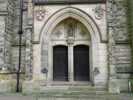For this church:    |
Ruddington St PeterStonework
Oolitic limestone with a light reddish cast was used extensively for the exterior of St Peter’s. This expensive limestone formation of the middle Jurassic age is likely to be from the Ancaster quarries in Leicestershire, often used in this area. Two plinths below the east window and by the west doors are more unusual, being of a finer red sandstone from the Mansfield area of Sherwood Forest. Above the west doors, centrally placed to the archway is a stone carving in a niche above the decorated capital; the figure represents St Peter, patron saint of the church. Two carvings higher up show the coats of arms of York and Southwell dioceses. The embattled tower dates from the thirteenth-century chapel of St Mary and was incorporated into the present building. It is similar to the churches in Keyworth and Cotgrave. Its great blocks of sandstone, probably Triassic sandstone from Castle Donington, form its main bulk with later window inserts. The chancel is paved with Hoptonwood limestone, a fine cream-coloured stone, almost like marble, from the middle Jurassic period, and the altar top has a polished version. It was first quarried about 1820 in Hopton Wood at the west end of the Via Gellia in Derbyshire, and has been used extensively for World War I headstones in France and by Barbara Hepworth. Fine-grained Jurassic limestone, mainly creamy in colour, and either from Caen or Cambridgeshire was used for the newer font, with red Devonshire pillars. This red sandstone is prevalent in a broad belt from the Somerset border down to the south Devon coast at Paignton. The small pillar in the very centre is made from dark Derbyshire limestone, an unusual feature. It is a sedimentary carbonate rock composed almost entirely of calcite and originally formed about 15 degrees south of the equator, millions of years ago. Thanks to Dr Graham Lott of the British Geological Survey for this information |






